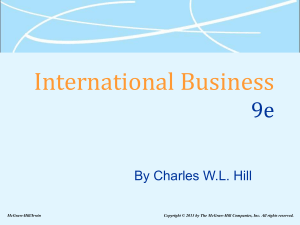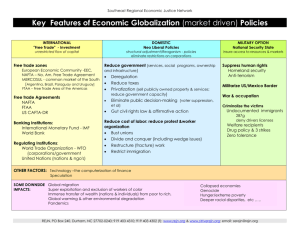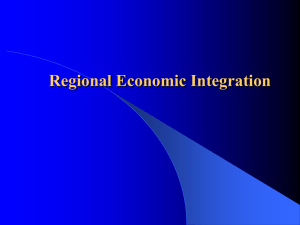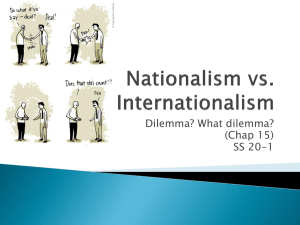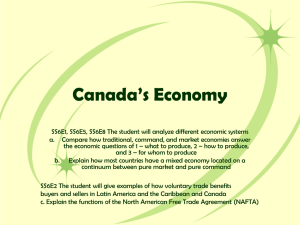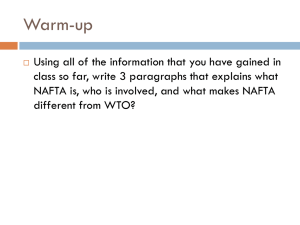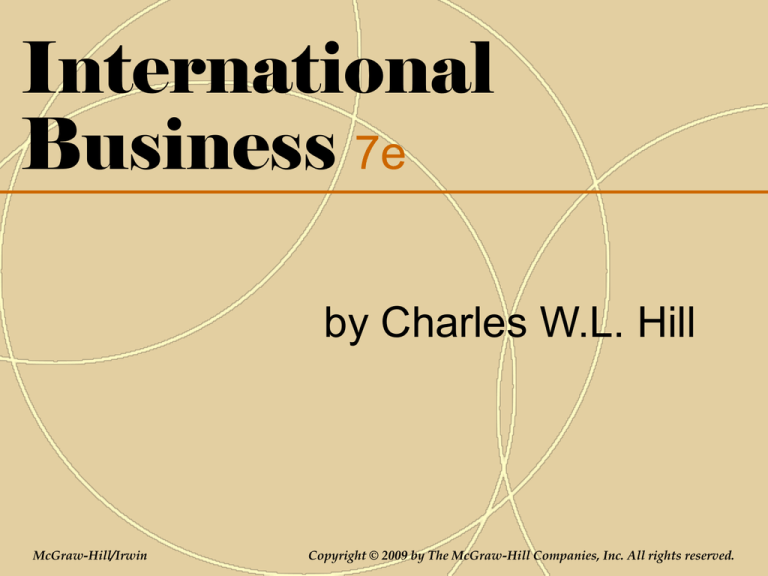
International
Business 7e
by Charles W.L. Hill
McGraw-Hill/Irwin
Copyright © 2009 by The McGraw-Hill Companies, Inc. All rights reserved.
Chapter 8
Regional Economic Integration
Introduction
Regional economic integration refers to agreements
between countries in a geographic region to reduce
tariff and non-tariff barriers to the free flow of goods,
services, and factors of production between each other
Regional trade agreements are designed to promote
free trade, but instead the world may be moving toward
a situation in which a number of regional trade blocks
compete against each other
8-3
Levels Of Economic Integration
There are five levels of economic integration:
1. a free trade area eliminates all barriers to the trade of
goods and services among member countries, but
members determine their own trade policies for
nonmembers
the European Free Trade Association (between
Norway, Iceland, Liechtenstein, and Switzerland), and
the North American Free Trade Agreement (between
the U.S., Canada, and Mexico) are both free trade
areas
8-4
Levels Of Economic Integration
2. a customs union eliminates trade barriers between
member countries and adopts a common external trade
policy
The Andean Pact (between Bolivia, Columbia,
Ecuador and Peru) is an example of a customs union
3. a common market has no barriers to trade between
member countries, a common external trade policy, and
the free movement of the factors of production
MERCOSUR (between Brazil, Argentina, Paraguay,
and Uruguay) is aiming for common market status
8-5
Levels Of Economic Integration
4. An economic union has the free flow of products and
factors of production between members, a common
external trade policy, a common currency, a harmonized
tax rates, and a common monetary and fiscal policy
The European Union (EU) is an imperfect economic
union
5. A political union involves a central political apparatus
that coordinates the economic, social, and foreign policy
of member states
The EU is headed toward at least partial political
union, and the United States is an example of even
closer political union
8-6
Levels Of Economic Integration
Figure 8.1
8-7
Classroom Performance System
All barriers to the free flow of goods and services
between member countries are removed, and a
common policy toward nonmembers is established in a
a) Free trade area
b) Customs union
c) Common market
d) Economic union
8-8
Classroom Performance System
NAFTA is an example of a(n)
a) Free trade area
b) Customs union
c) Common market
d) Economic union
8-9
The Economic Case For
Regional Integration
All countries gain from free trade and investment
Regional economic integration is an attempt to exploit
the gains from free trade and investment
8-10
The Political Case For Regional Integration
Linking countries together, making them more
dependent on each other:
creates incentives for political cooperation and
reduces the likelihood of violent conflict
gives countries greater political clout when dealing
with other nations
8-11
Impediments To Integration
Economic integration can be difficult because:
while a nation as a whole may benefit from a regional
free trade agreement, certain groups may lose
it implies a loss of national sovereignty
8-12
The Case Against Regional Integration
Regional economic integration is only beneficial if the
amount of trade it creates exceeds the amount it diverts
Trade creation occurs when low cost producers within
the free trade area replace high cost domestic
producers
Trade diversion occurs when higher cost suppliers
within the free trade area replace lower cost external
suppliers
8-13
Classroom Performance System
When higher cost suppliers within the free trade area
replace lower cost external suppliers
a) The bloc as a whole benefits
b) There is trade creation
c) There is trade diversion
d) External suppliers benefit
8-14
Regional Economic Integration In Europe
Europe has two trade blocs:
The European Union (EU) with 27 members
The European Free Trade Area (EFTA) with 4
members
The EU is seen as the world’s next economic and
political superpower
8-15
Regional Economic Integration In Europe
Map 8.1: Member States of the European Union in 2007
8-16
Evolution Of The European Union
The EU was formed as a result of the devastation of
two world wars on Western Europe and the desire for a
lasting peace, and the desire by the European nations
to hold their own on the world’s political and economic
stage
The forerunner of the EU was the European Coal and
Steel Community, which had the goal of removing
barriers to trade in coal, iron, steel, and scrap metal
formed in 1951
The European Economic Community was formed in
1957 at the Treaty of Rome with the goal of becoming a
common market
8-17
Political Structure Of The European Union
There are five main institutions of the EU:
the European Council - resolves major policy issues and sets
policy directions
the European Commission - responsible for implementing
aspects of EU law and monitoring member states to ensure they
are complying with EU laws
the Council of the European Union - the ultimate controlling
authority within the EU
the European Parliament - debates legislation proposed by the
commission and forwarded to it by the council
the Court of Justice - the supreme appeals court for EU law
8-18
Classroom Performance System
_______ is the ultimate decision making body of the
European Union.
a) Council of the European Union
b) European Parliament
c) Court of Justice
d) European Commission
8-19
Classroom Performance System
_______ is responsible for proposing EU legislation.
a) Council of the European Union
b) European Parliament
c) Court of Justice
d) European Commission
8-20
The Single European Act
The Single European Act:
was adopted by the EU in 1987
committed the EC countries to work toward
establishment of a single market by December 31, 1992
was born out of frustration among EC members that
the community was not living up to its promise
provided the impetus for the restructuring of
substantial sections of European industry allowing for
faster economic growth than would otherwise have
been the case
8-21
The Establishment Of The Euro
The Maastricht Treaty committed the EU to adopt a
single currency
By adopting the euro, the EU has created the second
largest currency zone in the world after that of the U.S.
dollar
The euro is used by 12 of the 25 member states
For now, three EU countries, Britain, Denmark and
Sweden, that are eligible to participate in the euro-zone,
are opting out
8-22
The Establishment Of The Euro
Benefits of the Euro:
There are savings from having to handle one currency, rather
than many
A common currency will make it easier to compare prices across
Europe
European producers will be forced to look for ways to reduce
their production costs in order to maintain their profit margins
It should give a strong boost to the development of highly liquid
pan-European capital market
A pan-European euro denominated capital market will increase
the range of investment options open both to individuals and
institutions
8-23
The Establishment Of The Euro
Costs of the Euro:
National authorities lose control over the monetary
policy
The EU is not an optimal currency area (an area
where similarities in the underlying structure if economic
activities make it feasible to adopt a single currency and
use a single exchange rate as an instrument of macroeconomic policy)
8-24
The Establishment Of The Euro
Since its establishment January 1, 1999, the euro has
had a volatile trading history with the U.S. dollar
Initially, the euro fell in value relative to the dollar, but
strengthened to a five year high of $1.30 in February
2006
8-25
Enlargement Of The European Union
Many countries have applied for EU membership
Ten countries joined on May 1, 2004 expanding the
EU to 25 states, with population of 450 million people,
and a single continental economy with a GDP of €11
trillion
In 2007, Bulgaria and Romania joined bring
membership to 27 countries
The new countries will not be able to adopt the euro
until at least 2007, nor will there be free movement of
labor between new and existing countries until then
8-26
Regional Economic Integration
In The Americas
There is a move toward greater regional economic
integration in the Americas
The biggest effort is the North American Free Trade
Area (NAFTA)
Other efforts include the Andean Community and
MERCOSUR
A hemisphere-wide Free Trade of the Americas is
under discussion
8-27
The North American Free Trade Agreement
The North American Free Trade Area (NAFTA)
became law January 1, 1994
NAFTA’s participants are the United States, Canada,
and Mexico
8-28
The North American Free Trade Agreement
Map 8.2
8-29
The North American Free Trade Agreement
NAFTA:
abolished tariffs on 99 percent of the goods traded between
members
removed most barriers on the cross-border flow of services
protects intellectual property rights
removes most restrictions on FDI between the three member
countries
allows each country to apply its own environmental standards,
provided such standards have a scientific base
establishes two commissions to impose fines and remove trade
privileges when environmental standards or legislation involving
health and safety, minimum wages, or child labor are ignored
8-30
The North American Free Trade Agreement
NAFTA’s supporters argue that:
Mexico will benefit from increased jobs as low cost
production moves south, and will attain more rapid
economic growth as a result
The U.S. and Canada will benefit from the access to a
large and increasingly prosperous market and from the
lower prices for consumers from goods produced in
Mexico
U.S. and Canadian firms with production sites in
Mexico will be more competitive on world markets
8-31
The North American Free Trade Agreement
Critics of NAFTA’s argued that:
that jobs would be lost and wage levels would decline
in the U.S. and Canada
Mexican workers would emigrate north
pollution would increase due to Mexico's more lax
standards
Mexico would lose its sovereignty
8-32
The North American Free Trade Agreement
Research indicates that NAFTA’s early impact was
subtle, and both advocates and detractors may have
been guilty of exaggeration
The agreement has helped to create the background
for increased political stability in Mexico
Several other Latin American countries have indicated
their desire to eventually join NAFTA
Currently both Canada and the U.S. are adopting a
wait and see attitude with regard to most countries
8-33
The Andean Community
The Andean Pact:
was formed in 1969 using the EU model
had more or less failed by the mid-1980s
was re-launched in 1990, and now operates as a
customs union
signed an agreement in 2003 with MERCOSUR to
restart negotiations towards the creation of a free trade
area
8-34
MERCOSUR
MERCOSUR:
originated in 1988 as a free trade pact between Brazil
and Argentina
was expanded in 1990 to include Paraguay and
Uruguay
has been making progress on reducing trade barriers
between member states
may be diverting trade rather than creating trade, and
local firms are investing in industries that are not
competitive on a worldwide basis
8-35
Central American Common
Market And CARICOM
There are two other trade pacts in the Americas:
the Central American Trade Market (CAFTA) – to
lower trade barriers between the U.S. and members
CARICOM – to establish a customs union
Neither pact has achieved its goals yet
In 2006, six CARICOM members formed the
Caribbean Single Market and Economy (CSME) - to
lower trade barriers and harmonize macro-economic
and monetary policy between members
8-36
Free Trade Of The Americas
Talks began in April 1998 to establish a Free Trade of
The Americas (FTAA) by 2005
The FTAA was not established and now support from
the U.S. and Brazil is mixed
If the FTAA is established, it will have major
implications for cross-border trade and investment flows
within the hemisphere
The FTAA would create a free trade area of nearly
800 million people
8-37
Regional Economic Integration Elsewhere
Several efforts have been made to integrate in Asia
and Africa
One of the most successful is the Association of
Southeast Asian Nations (ASEAN)
8-38
Association Of
Southeast Asian Nations
The Association of Southeast Asian Nations (ASEAN):
was formed in 1967
currently includes Brunei, Indonesia, Malaysia, the
Philippines, Singapore, Thailand, Vietnam, Myanmar,
Laos, and Cambodia
wants to foster freer trade between member countries
and to achieve some cooperation in their industrial
policies
an ASEAN Free Trade Area (AFTA) between the six
original members of ASEAN came into effect in 2003
8-39
Association Of
Southeast Asian Nations
Map 8.3
8-40
Asia-Pacific Economic Cooperation
The Asia-Pacific Economic Cooperation (APEC):
currently has 21 members including the United
States, Japan, and China
wants to increase multilateral cooperation in view of
the economic rise of the Pacific nations and the growing
interdependence within the region
8-41
Asia-Pacific Economic Cooperation
Map 8.4
8-42
Regional Trade Blocs In Africa
Progress toward the establishment of meaningful
trade blocs in Africa has been slow
Many countries are members of more than one of the
nine dormant blocs in the region
Kenya, Uganda, and Tanzania committed to relaunching the East African Community (EAC) in 2001,
however so far, the effort appears futile
8-43
Implications For Managers
The EU and NAFTA currently have the most
immediate implications for business
8-44
Opportunities
Regional economic integration:
opens new markets
makes it possible for firms to realize potentially
enormous cost economies by centralizing production in
those locations where the mix of factor costs and skills
is optimal
8-45
Threats
Within each grouping, the business environment
becomes competitive
EU companies are becoming more capable
There is a risk of being shut out of the single market
by the creation of a “trade fortress”
The EU is becoming more willing to intervene and
impose conditions on companies proposing mergers
and acquisitions which could limit the ability of firms to
follow the strategy of their choice
8-46
Classroom Performance System
Which of the following is not true of NAFTA?
a) It created a free trade area of nearly 800 million
people
b) It created the background for increased political
stability in Mexico
c) Several other Latin American countries have
indicated their desire to eventually join NAFTA
d) Its participants are the United States, Canada, and
Mexico
8-47

